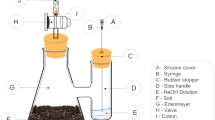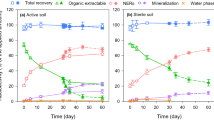Abstract
[14C]-MBOCA [4,4′-methylene-bis (2-chloroaniline)] was rapidly bound to soil with most of the binding occurring within the first 24 hr after application. After 24 weeks, less than 20% of the radio-activity could be extracted from soil and less than 6% could be extracted as parent MBOCA. MBOCA has a water solubility of 13.9 mg/L and the MBOCA-soil adsorption isotherm indicates a strong affinity of MBOCA to soil. The predominant metabolite found in the non-sterile soil was identified as 4,4′-diamino-3,3′-dichlorobenzophenone. Less than 1% of applied radioactivity was released as [14C]-CO2 during the 24 week experiment, indicating that soil microbes were capable of very limited mineralization of MBOCA.
Similar content being viewed by others
References
Bartha R (1971) Fate of herbicide-derived chloroanilines in soil. J Agric Food Chem 19:385–387
Boyd SA, Kao Chun-Wei, Suflita JM (1984) Fate of 3,3′-dichlorobenzidine in soil: persistence and binding. Environ Toxicol Chem 3:201–208
Chin B, Tobes MC, Han SS (1983) Absorption of 4,4′-methylenebis[2-chloroaniline] by human skin. Environ Res 32:167–178
Hsu TS, Bartha R (1974a) Interaction of pesticide-derived chloroaniline residues with soil organic matter. Soil Sci 116:444–452
— (1974b) Biodegradation of chloroaniline-humus complexes in soil and in culture solution. Soil Sci 118:213–220
— (1976) hydrolyzable and non-hydrolyzable 3,4-dichloroaniline-humus complexes and their respective rates of biodegradation. J Agric Food Chem 24:118–122
Kaufman DD, Plimmer JR, Klingebiel UI (1973) Microbial oxidation of 4-chloroaniline. J Agric Food Chem 21:127–132
Linch AL, O'Connor GB, Barnes JR, Killian AS, Neeld WE (1971) Methylene-bis-ortho-chloroaniline (MOCA): Evaluation of hazards and exposure control. Am Indus Hyg Assoc J 32:802–819
Michigan Department of Natural Resources (1979) Curene Contamination in Adrian. Summary of investigations to July 25, 1979 Lansing, MI
Morton KC, King CM, Baetcke KP (1979) Metabolism of benzidine to.N-hydroxy-N,N'-diacetyl-benzidine and subsequent nucleic acid binding and mutagenicity. Cancer Res 39:3107–3113
National Institute of Occupational Safety and Health (NIOSH) (1978) Special hazard review with control recommendations for 4,4′-methylene-bis (2-chloroaniline). US Dept Health, Education, and Welfare Publication No. 78-188 Washington, DC
Parris GE (1980) Covalent binding of aromatic anilines to humates: 1. Reactions with carbonyls and quinones. Environ Sci Technol 14:1099–1106
Probst GW, Golab T, Herberg RJ, Holzer FJ, Parka SJ, Van der Schans C, Tepe JB (1966) Fate of trifluralin in soils and plants. J Agric Food Chem 15:592–599
Russfield AB, Homburger F, Boger E, Van Dongen CG, Weisburger EK, Weisburger JH (1975) The carcinogenic effect of 4,4′-methylene-bis(2-chloroaniline) in mice and rats. Toxicol Appl Pharmacol 31:47–54
Saxena A, Bartha R. (1983) Binding of 3,4-dichloroaniline by humic acid and soil: Mechanism and exchangeability. Soil Sci 136:111–116
Still GG, Balba HM, Mansager ER (1981) Studies on the nature and identity of bound chloroaniline residues in plants. J Agric Food Chem 29:739–746
Stula EF, Sherman H, Zapp JA, Clayton JW (1975) Experimental neoplasia in rats from oral administration of 3,3′-dichlorobenzidine, 4,4′-methylene-bis (2-chloroaniline), and 4,4′-methylene-bis (2-methylaniline). Toxicol Appl Pharmacol 31:159–176
Stula EF, Barnes JR, Sherman H, Reinhardt CF, Zapp JA (1977) Urinary bladder tumors in dogs from 4,4′-methylene-bis (2chloroaniline) (MOCA). J Environ Path Toxicol 1:31–50
Wedemeyer G (1976) Biodegradation of dichlorodiphenyl trichloroethane: Intermdiates in dichlorodiphenyl acetic acid metabolism byAerobacter aerogenes. Appl Microbiol 15:1494–1495
Weed Science Society of America (1979) Herbicide handbook, 4th ed. Weed Science Society of America, Champaign, IL
Yoneyama K, Matsumura F (1984) Microbial metabolism of 4,4′-methylene-bis-(2-chloroaniline). Arch Environ Contam Toxicol 13:501–507
Zierath DL, Hasset JJ, Banwart WL, Wood SG, Means JC (1980) Sorption of benzidine by sediments and soils. Soil Sci 129:277–281
Author information
Authors and Affiliations
Additional information
Michigan Agric. Exp. Sta. Journal Article No. 11868.
Rights and permissions
About this article
Cite this article
Voorman, R., Penner, D. Fate of MBOCA [4,4′-methylene-bis (2-chloroaniline)] in soil. Arch. Environ. Contam. Toxicol. 15, 595–602 (1986). https://doi.org/10.1007/BF01056574
Received:
Revised:
Issue Date:
DOI: https://doi.org/10.1007/BF01056574




